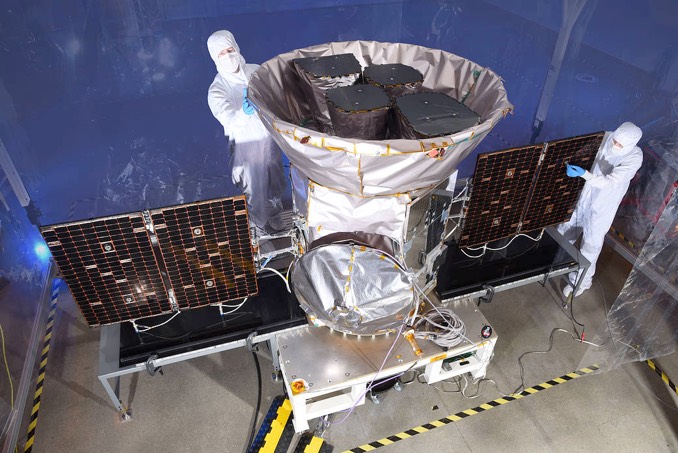
NASA’s Transiting Exoplanet Survey Satellite, or TESS, is on track to re-write exoplanet textbooks, astronomers say, discovering three confirmed worlds in its first three months of observations, nearly 300 exoplanet candidates and 100 transient events, including six supernovae detected before they were seen by ground-based telescopes.
“The data floodgates are just beginning to open,” said George Ricker, the principal investigator. “When the full set of observations of more than 300 million stars and galaxies collected in the two-year prime mission are scrutinized by astronomers worldwide, TESS may well have discovered as many as 10,000 planets, in addition to hundreds of supernovae and other explosive stellar and extragalactic transients.”
The first confirmed exoplanet discovery, Pi Mensae c, is about twice the size of Earth, orbiting a Sun-like star 60 light years away that is visible to the unaided eye in the southern constellation Mensa
“This star was already known to host a planet, called Pi Mensae b, which is about 10 times the mass of Jupiter and follows a long and very eccentric orbit,” said Chelsea Huang, a researcher at the Massachusetts Institute of Technology’s Kavli Institute for Astrophysics and Space Research. “In contrast, the new planet, called Pi Mensae c, has a circular orbit close to the star, and these orbital differences will prove key to understanding how this unusual system formed.”
The video below, presented 7 January at the 217th meeting of the American Astronomical Society in Seattle, shows where Pi Mensae b and the other newly discovered exoplanets are located in TESS’s initial observation sector.
The second confirmed planet is known as LHS 3884b, a rocky world about 1.3 times the size of Earth orbiting a cool M-type dwarf 49 light years away in the constellation Indus. It is among the closest exoplanets yet found, completing one orbit every 11 hours. Temperatures on the surface are high enough to form pools of molten lava.
The third discovery, HD21749b, is about three times the size of Earth with 23 times its mass, orbiting a star 53 light years away in the southern constellation Reticulum. Its orbital period, or year, is 36 days and it likely has a surface temperature around 150 degrees Celsius (300 Fahrenheit).
“This planet has a greater density than Neptune, but it isn’t rocky,” said Diana Dragomir, a Hubble Fellow at MKI and lead author of a paper describing the discovery. “It could be a water planet or have some other type of substantial atmosphere.”
The data hint at the presence of a second planet, this one about the size of Earth, that orbits the star every eight days.
Launched last April, TESS is equipped with four 16.8-megapixel cameras, each one using four CCD detectors, that will spend at least two years monitoring starlight, sector by sector, across 85 percent of the sky, on the lookout for the tell-tale dimming that occurs when a planet moves, or transits, across its parent star as viewed from the spacecraft.
Studying how the light repeatedly dims and brightens, astronomers can detect planets ranging from Earth-size to gas giants larger than Jupiter, determine the nature of their orbits and distances from their host stars. Discoveries by TESS will be followed up by observations by ground-based instruments and other spacecraft, including the James Webb Space Telescope.
TESS is a followup to NASA’s trail-blazing Kepler probe, which discovered more than 2,600 planets beyond Earth’s solar system during its nine-year mission.
Along with exoplanets, TESS’s cameras also can detect transient events, the sudden brightening that occurs with supernova explosions and other high-energy phenomena. In the first sector TESS monitored, between 25 July and 22 August of 2018, dozens of short-lived events were observed including six supernovae in galaxies that later were spotted by ground-based instruments.
“Some of the most interesting science occurs in the early days of a supernova, which has been very difficult to observe before TESS,” said Michael Fausnaugh, a TESS researcher at MKI. “NASA’s Kepler space telescope caught five of these events as they brightened during its first four years of operations. TESS found as many in its first month.”



